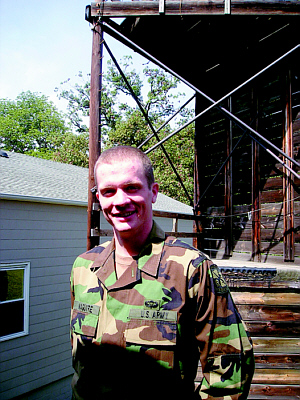First Person —
Summer Training 2004: Airborne School and
Robin Sage

Cadet Gavin Maguire
PHOTO BY HPS/WILL KIRK
|
By Cadet Gavin Maguire
Editor's note: This is the first in an occasional
series of first-person accounts of activities in which members of
the Johns Hopkins community participate. Ideas and submissions
are invited from faculty, staff and students. The topic must be
university-related. Please contact us at
gazette@jhu.edu or
443-287-9900.
For five weeks this summer I did things that so many only
dream about. I was able to jump out of a perfectly good airplane
five times; I trained with the world-renowned Green Berets; I was
given the opportunity to use some of the U.S. Army's best
equipment, equipment that most only see in movies. These
experiences represent only a few of the many summer training
opportunities available to the ROTC cadet.
From 23 June to 16 July, I attended the three-week course
known as Airborne School at Fort Benning, Ga. Generally, Airborne
School — or "Jump School" — is divided into three
separate weeks of training: Ground Week, Tower Week and Jump
Week. During Ground and Tower weeks, an Airborne student is
instructed on how to properly exit the aircraft, control his
descent under canopy, prepare to land and land utilizing a proper
parachute landing fall, or PLF. Physical training geared toward
preparing the jumper for Jump Week and for general physical
conditioning is interspersed throughout Ground and Tower weeks.
The first two weeks, though, are simply the step-by-step
instruction and training that prepares a soldier for his or her
final exam: Jump Week!
During Jump Week, an Airborne student must execute five
static-line jumps from an altitude of approximately 1,000-1,200
feet to qualify as a Basic Parachutist, thus authorizing the
wearing of the Basic Parachutist Badge — or "Jump Wings"
— on any of the Army's uniforms. Two of the five jumps are
with combat equipment, one of them at night. There are about
50-60 seconds of canopy time between exit and landing when one
can enjoy the view, but the goal of Army parachuting is to safely
get to the ground as quickly as possible, so it's a far cry from
civilian parachuting. However, once earning his Jump Wings, the
newly minted paratrooper will take his place in a long line of
Airborne soldiers, men and women, dating back to 1940.
Following Jump School, I almost immediately packed my
equipment and flew down to North Carolina. I was bused to Camp
McCall, an auxiliary camp of Fort Bragg, N.C., the home of the
Special Forces. The reason I was down there was to act as a
guerilla in the fourth phase (of six) of Special Forces training,
known as Robin Sage. Generally, the role of the U.S. Special
Forces is to go behind enemy lines and train indigenous peoples
who are fighting an oppressive enemy with the idea that those
indigenous people will, one day, be able to fight on their own.
So, this two-week phase of the Special Forces candidates'
approximately two year-long training is a field exercise designed
to evaluate their ability to establish a rapport, train and
execute missions with a guerilla force.
Myself, along with about 25 other "guerillas," or "Gs," were
a part of a guerilla band led by our "Guerilla Chief," who, in
actuality, was a retired SF soldier with 20-plus years of
service. The team that came in to "train" us was made up of two
officers, three weapons and tactics specialists, three engineers,
two medics and two communications specialists, 12 in all. The
entire group — the "Gs" as well as the A-Team — slept
out in the woods for two weeks straight. Our days were spent
receiving training in tactics, demolitions, survival,
communications, first aid and so on. We (the Gs) also helped in
planning, briefing and executing operations orders, the
fundamental method of disseminating a mission in the Army.
We were able to use weapons such as the M4, AK-47 and M249
Squad Automatic Weapon in our missions, albeit with blanks, not
live rounds. We set up a drop zone to receive a bundle of
equipment and supplies that was dropped out of a passing
aircraft. We set up landing zones to facilitate the air
evacuation of a "downed pilot." We were able to utilize
state-of-the-art Army communications equipment as well as night
vision goggles. We also were able to kill and butcher a pig,
which fed the camp for about three days (a pleasant break from
our steady diet of "Meals, Ready to Eat," the Army's field
ration). But possibly the best part of Robin Sage was to have
access to some of the best soldiers in the entire world —
to hear their experiences and to learn just a fraction of what
they know. It's interesting to note that all of these soldiers
were very normal guys who really didn't look or act any different
than any other soldier, or civilian for that matter; they were
just very driven and very dedicated to the United States.
Airborne School and Robin Sage couldn't have been more
different types of Army training, but ultimately they were both
fantastic experiences for me. They are basically "internships" in
the Army that give practical experience, an insight into the
Army, build confidence and hone leadership. I am now just looking
forward to more opportunities to learn and grow, either while
still a cadet or as a commissioned officer in the U.S. Army.

A member of Johns Hopkins University Army ROTC, Gavin Maguire
is a junior majoring in international studies. His hometown is
Olney, Md.
 GO TO SEPTEMBER 20, 2004
TABLE OF CONTENTS.
GO TO SEPTEMBER 20, 2004
TABLE OF CONTENTS.
 GO TO THE GAZETTE
FRONT PAGE.
GO TO THE GAZETTE
FRONT PAGE.
|